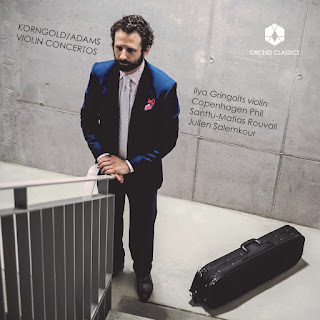 Two twentieth century violin concertos, stylistically polar
opposites, but with a common emphasis on melody. Written by two very
different composers who nevertheless, each in his own time, rejected the
mid-20th century ascendancy of atonality and the serial composition of
music.
Two twentieth century violin concertos, stylistically polar
opposites, but with a common emphasis on melody. Written by two very
different composers who nevertheless, each in his own time, rejected the
mid-20th century ascendancy of atonality and the serial composition of
music.
John Adams (b.1947) is a composer who does not like to be pinned
down. Being branded a minimalist has not suited him any better than did
the confines of his training in the twelve-tone system while he was a
student at Harvard. Adams has said that “it’s taken me 20 years to
escape the corrosive effects of graduate school.” Indeed, his style has
continued to evolve since his early association with the so-called
minimalists Philip Glass and Steve Reich. The term itself is a bit of a
misnomer – it is difficult to point to anything minimal in Glass’
Einstein on the Beach or Reich’s Desert Music. Musicologist Richard
Taruskin prefers the term “Pattern and Process” music, which highlights
the tendency of these composers to set patterns in motion within dense,
rhythmically complex textures, and then gradually morph these patterns
over time. But perhaps what the term refers to – aside from the hallmark
components of repetition and a steady, often entirely unchanging pulse –
is the dearth of melody that typifies the style. Adams himself
recognized the incompatibility of this particular element of his music
with the genre of the violin concerto:
“I knew that if I were to compose a violin concerto I would have to
solve the issue of melody. I could not possibly have produced such a
thing in the 1980s because my compositional language was principally one
of massed sonorities riding on great rippling waves of energy. Harmony
and rhythm were the driving forces in my music of that decade; melody
was almost non-existent.”
As if in reaction to having pushed melody aside for so long, the
Violin Concerto, composed in 1993, is relentlessly, unforgivingly,
melodic. Adams has called it “hypermelodic.” The entire piece is
essentially one prolonged, continuously unfolding melody for the solo
violin. Not that repetition as a device has disappeared from his music –
the first movement sets the solo violin’s endless melody over
persistent, steadily rising eighth-note figures in the orchestra. The
second movement pays homage to a time-honoured repetitive form, one
which moreover holds a cherished position in the violinist’s repertoire:
the chaconne. Adams evokes a second duality here, beyond that of
orchestra / solo instrument, with the association of a poem by American
Robert Haas, “Body Through Which the Dream Flows.” The movement’s
ethereal beauty is difficult to account for, but it is easy to imagine
the solo violin’s fleeting, other-worldly imagery flowing through the
sublime, yet corporeal sounds of the orchestra. The third movement is a
satisfyingly virtuosic romp, with thrillingly “minimalist” writing for
the orchestra, all the while maintaining unrelenting melodic invention
in the solo violin part.
Erich Korngold’s Violin Concerto, premiered in 1947, might also be
called “hypermelodic.” Korngold (1897-1957) himself noted that the
concerto, “with its many melodic and lyric episodes was contemplated
rather for a Caruso of the violin than for a Paganini.” Written at a
time in music history where atonality held nearly undisputed sway in
musically sophisticated circles (Korngold’s music is emphatically tonal,
if harmonically complex), the work was the first in what Korngold hoped
would be his triumphant return to concert music, after a long and
celebrated career as Hollywood’s preeminent film composer. The piece
contains material in each of its three movements from several of
Korngold’s film scores, the rights to which he had shrewdly secured for
himself in his contracts with the film studios.
Korngold in many ways single-handedly defined the genre of the film
score, but in spite of his success he was plagued by the notion that he
had sold his talents too cheaply – that a “true” composer wrote music
for the concert hall and operatic stage. Korngold was well-established
as an opera composer in Vienna when he came to Hollywood for the first
time in 1934. He returned in 1938 to write the score for 1938’s
ground-breaking Robin Hood, starring Errol Flynn. Hitler’s Anschluss in
March of that year intervened, and Korngold elected to stay in
California, vowing to support his family by writing music for films
until Hitler was defeated. (Orchid Classics)




No hay comentarios:
Publicar un comentario